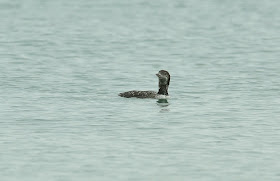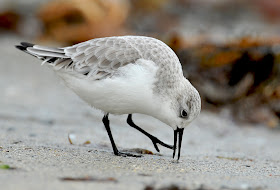 Corvids are not the most photographed birds but these shots show that the family can be quite photogenic! They were taken at close range and show quite a lot of feather detail and subtle colour. Needless to say, I used the 600m lens without a converter and in full frame mode, rather than DX crop mode. WB set to Cloudy, Exposure 0.0, ISO500, Shutter Speed 500th sec. The Carrion Crow photo has caught the eye lid blinking, hence the blue colour.
Corvids are not the most photographed birds but these shots show that the family can be quite photogenic! They were taken at close range and show quite a lot of feather detail and subtle colour. Needless to say, I used the 600m lens without a converter and in full frame mode, rather than DX crop mode. WB set to Cloudy, Exposure 0.0, ISO500, Shutter Speed 500th sec. The Carrion Crow photo has caught the eye lid blinking, hence the blue colour.Pages
▼
Sunday, 30 November 2008
Corvids at Copperhouse
 Corvids are not the most photographed birds but these shots show that the family can be quite photogenic! They were taken at close range and show quite a lot of feather detail and subtle colour. Needless to say, I used the 600m lens without a converter and in full frame mode, rather than DX crop mode. WB set to Cloudy, Exposure 0.0, ISO500, Shutter Speed 500th sec. The Carrion Crow photo has caught the eye lid blinking, hence the blue colour.
Corvids are not the most photographed birds but these shots show that the family can be quite photogenic! They were taken at close range and show quite a lot of feather detail and subtle colour. Needless to say, I used the 600m lens without a converter and in full frame mode, rather than DX crop mode. WB set to Cloudy, Exposure 0.0, ISO500, Shutter Speed 500th sec. The Carrion Crow photo has caught the eye lid blinking, hence the blue colour.Sunday, 23 November 2008
Bullfinch, Robin and Snipe at Stithians
On a cold and very windy day, these Bullfinch, Robin and Snipe shots were taken from Stithians hide and added some spice to a very wintery day. A family party of Bullfinch had been seen the previous day here, so after some five hours of waiting in the hide, we were rewarded with some reasonably close views. The light was extremely changeable and stupidly I forgot to check the exposure and ISO reading, resulting in a slightly over exposed Bullfinch image. Photoshop CS3 has corrected the error!




The three Common Snipe were showing in front of the hide virtually all morning. One of the birds is distinctively greyer and has a double streak on the front of its neck. It was regularly defending its roosting area by poking others who came too close.







The three Common Snipe were showing in front of the hide virtually all morning. One of the birds is distinctively greyer and has a double streak on the front of its neck. It was regularly defending its roosting area by poking others who came too close.



Friday, 21 November 2008
Redstart showing characteristics of samamisicus?
Below are some images of a redstart found by Daniel Eva at Helston Loe Pool on Sunday afternoon, 16th November 2008, showing some characteristics of the eastern form of redstart. It was later video'd by John Chapple and photographed by Kate Jones. Daniel was surprised how pale and sandy coloured the bird was. In addition, the pale edges to the tertials and secondaries formed a panel in the wing. Any constructive comments on the identification would be welcome. The bird was observed in typical woodland habitat and the light was fairly dull under the canopy. The three shots below were the best that Kate could obtain given the dull light.






Sunday, 16 November 2008
Red-legged Partridge at Caerhays


I was lucky to spot these Red-legs close to the roadside at Caerhays Castle near Portholland and took the shots from the car window. Pheasants are bred in this area specially for shooting parties and the partridges take advantage and feed on the provided seed. The light was good. The camera was in Aperture Priority (as always). The aperture was raised to f/5.6 and resulting shutter speed was high at approx 1000th sec.
Divers in Gerrans Bay
Three Black-throated Divers look on in envy as the adult Great Northern catches a flat fish. The moulting Great Northern came to within 40 yards of the water's edge on the beach and took ten minutes to swallow its prey. Exposure set to 0.0 White Balance cloudy. ISO 400. Shutter speed 500th sec. Gerrans Bay is the best site in Cornwall to find wintering divers, especially Black-throated. The area is nationally important for divers and grebes and flocks of 60 plus Black-throats have been recorded here in the past. Red-throated Diver is the least common. The area is also reliable for wintering Red-necked, Slavonian and Black-necked Grebes. Great-cresteds have also become more frequent in recent years.
Saturday, 15 November 2008
A charm of Goldfinches at Portscatho
These delightful Goldfinches were feeding on the seed heads about 20 feet in front of me near the harbour wall at Portscatho. The sun was low and briefly quite strong, just giving me enough time to take about 15 shots. The shutter speed was quite high at 500th second, aperture f/8, exposure -0.3 and White Balance as always, was set to Cloudy. This setting seems to yield a warmer image. All the shots were in focus and these were the best of the crop. I've been waiting some time to photograph Goldfinch as they can be very skittish, but these shots have been worth the wait.

Tuesday, 11 November 2008
Lapwing holds court
I photographed these Lapwing today and observed one bird dropping in by the main group, which had formed a loose circle. The new arrival landed just outside the main group and hovered and wing stretched, reminding me of a Storm Petrel at sea! Taken with Nikon D3 and 600mm F/4 with no teleconverters or in-camera crop mode. The D3, when used in the intended FX (full-frame) mode, retains its full 12 mega pixel images but when used in the DX mode, reduces to 5 mega pixel but increases the focal length by c.1.5x. The drawback though is you lose cropping capability later in the "digital darkroom". The images below have been given the full treatment tonight! They have been cropped two-fold, exposure altered upwards by half a stop, warm camera filter applied, shadows and highlights enhanced, and the clone stamp used to remove intrusions!


Sunday, 9 November 2008
Sanderling at Portscatho beach

This stunning Sanderling, complete in winter plumage was photographed on the beach tide-line this morning at Portscatho, Gerrans Bay. The weather was overcast with heavy, dark grey cloud and this lovely light seems to compliment the snow white colours of Sanderling. I took about 200 shots and virtually all were in focus. The bird was confiding and as such a tele converter was not used. ISO 640. Exposure - 0.3 . White Balance set to Cloudy. Shutter speed 500 th/sec. The images have been cropped and tidied up in CS3.

Wednesday, 5 November 2008
Lapwings roosting and preening
This Lapwing was one of thirty birds which just happened to be closer than the rest. It was about 25 yards distance and quite content to bathe and preen in front of me. The light was good. Exposure was set at 0.0 and White Balance set to Auto. Tripod mounted. All of the images have been cropped 1x in Adobe Photoshop CS3 and two of the images have been Exposure corrected.
Sunday, 2 November 2008
A Mediterranean feel to Cornwall


At Stithians Res today, at least four different Mediterranean Gulls were present in the morning at different times. They use the freshwater to bathe and preen and then move back to the coast or fields to feed. All the shots were taken with the 600mm lens coupled to the 1.7x tele converter. Light was good and the resulting shutter speed got up to 1000th sec. Aperture F/6.7. ISO 800. Exposure 0.0 . The image of the green ringed adult bird (right leg) above can be zoomed in and has the ring number 3EK2. This bird was originally ringed in Belgium in 2002/20/04/ (2002 as an adult) Zandvlietsluis, Antwerpen. It was subsequently recorded at Swanpool between 2003 and 2006. The bird was then recorded in France (Pas De Calais) 12 months later. The next sighting was three months later in Jan 2008 in Cornwall at Men-aver beach, Gillan. It was then recorded on Gyllingvase Beach, Falmouth in July finally arriving at Stithians reservoir on the 31st October and again on the 2nd November. (per S. Taylor).




Above left: Adult with a green ring, but a different mask structure to the other adults in this sequence. Above right: adult bird with no visible rings (although the foot is obscured). The structure of the black mask is also subtlely different with a more prominent downward sweep at the ear coverts.
Above left: Bird 3KN7 with green ring on left leg and above right, an adult and first winter bird together.



































